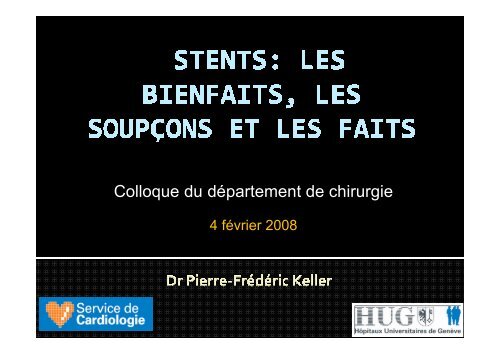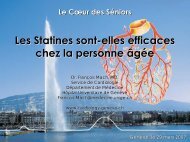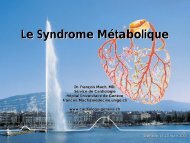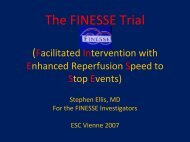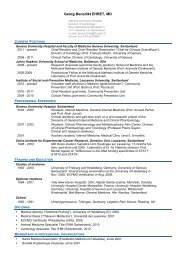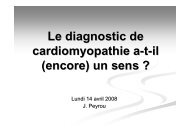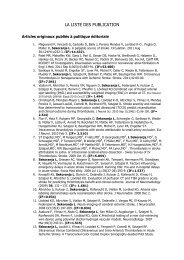In-Stent Thrombosis
In-Stent Thrombosis
In-Stent Thrombosis
- No tags were found...
Create successful ePaper yourself
Turn your PDF publications into a flip-book with our unique Google optimized e-Paper software.
Colloque du département de chirurgie4 février 2008
%Circulation. 1989;80:421– 428Ann <strong>In</strong>tern Med. 2003;138:777–786
Death, revascularization of the target lesion,angiographically evident thrombosis, or myocardialinfarctionN Engl J Med 1998;339:1665-71
K. Toutouzas. Eur Heart J. 2004
Keller P-F. Expert Opin Emerg Drugs. 2005 Feb;10(1):67-86
Bare Metal <strong>Stent</strong> (BMS)DES to fight restenosisDrug Eluting <strong>Stent</strong> (DES)
RAVEL: Resultsn=237, 6 months follow-upAngiographic Restenosis (%)30%25%20%15%10%5%RestenosisP
6–12 months of angio & clinical FU, n=5103DES vs BMSBabapulle MN. Lancet 2004; 364: 583Forest plot comparing rates of angiographicrestenosis for DES and for BMSForest plot comparing rates of MACE for DESand for BMSForest plot comparing all-cause mortality ratesfor DES and for BMSForest plot comparing MI rates for DES and forBMS
Concern about Drug Eluting-<strong>Stent</strong>s:<strong>In</strong>-<strong>Stent</strong> <strong>Thrombosis</strong>?
◦ Definite: ACS + angio or autopsy of stentthrombosis◦ Probable: Probable stent thrombosisincluded unexplained deaths within 30daysafter the procedure or acute myocardialinfarction involving the target-vesselterritory without angiographic confirmation.
◦ Possible stent thrombosisincluded all unexplained deaths occurringat least 30 days after the procedure.<strong>In</strong>tervening target lesion revascularizationwas defined as any repeatedpercutaneous revascularization of thestented segment, including the 5-mmproximal and distal margins, that precededstent thrombosis.
Stone G. ACC 2006
Stone G. ACC 2006
Stone G. ACC 2006
Eur Heart J 2005; 26: 1180–1187BMSN=6058Lancet 2007; 369: 667–78DESN=8146
Late thrombosis 0.19%. 12-months actuarial incidence of stent thrombosis 0.87%<strong>Stent</strong> thrombosisN=126 (0.87%)3628 %3528 %Cardiac deathN=20551 stent thrombosis (25%)3931 %1613 %41% mortalityMyocardial infarctionN=16855 stent thrombosis (33%)n = 15’157 patientsUrban P. Circulation. 2006;113:1434
N=2229 consecutive ptsMortality : 45%%1.81.61.41.210.80.60.40.201.3 %0.8 %<strong>Thrombosis</strong>1.7 %p=NSTotalSESPES12 months FUClopidogrel or Ticlopidine : 3 months for SES, 6 months for PESIakovou I. JAMA.2005;293:2126
<strong>In</strong>dependent predictors of stent thrombosis (ST)Am J Cardiol 2006;98:352–356
N=8146ST=152Lancet 2007; 369: 667–78
Daemen J. Lancet. 2007 May 26;369(9575):1785-1786
Décision de la FDA en décembre 2006 dereconnaître l’indication au Clopidogrel pour unedurée de 12 mois après l’implantation d’un stentmédicamentéDaemen J. Lancet. 2007 May 26;369(9575):1785-1786
• The incidence of stent thrombosis isincreased between 31 and 365 daysfor DES compared with BMS• Clopidogrel withdrawal is correlatedwith the increased risk ofstent thrombosis
CURE: Early & Long-Term Benefits ofClopidogrel following an ACS w or w/o141210<strong>Stent</strong>Cumulative Events [%](Cardiovascular Death, Myocardial <strong>In</strong>farction, or Stroke)Benefits were seen within hoursand continued to increaseover the 12 months8642AspirinClopidogrel + Aspirin20% RRRp=0.00009n=12,56200 1 2 3 4 5 6 7 8 9 10 11 12Months of follow-upN Eng J Med 2001;345:494
Angine stable Angine instable NSTEMI STEMIPrise en charge:Traitement médicalPCItraitement médical+/-PCIPCI+traitement médicalPCI, thrombolyse+traitement médicalAntiplaquettaires lors traitement médical:AASClopidogrel si intoléranceClopidogrel + AAS: 9-12 mois(ESC Guidelines on NST-ACS 2002)Par analogie avec NSTEMI:Clopidogrel+AAS: 9-12 moisAntiplaquettaires lors de PCI:BMS: 4 sem.DES: min. 12 moisDilatation, BMS: 9-12 moisDES: min. 12 moisDose de chargeUtiliser dose de charge de 300 mg.Si > 6h avant intervention 300mg, si < 6h utiliser 600 mg.Lors de PCI primaire etthrombolyse: dose de chargede 600 mg.
◦ 383 patients with known CAD were hospitalized forACS:• 51 (13.3%) of these ACSs occurred within 1 month afteraspirin withdrawal.• 10 pts (20%) had a thrombosis of Bare Metal <strong>Stent</strong>implanted on average 15.5–6.5 months previously.Ferrari E. J Am Coll Cardiol 2005;45:456
J Am Coll Cardiol 2000;35:128840 patients underwent surgery 1 to 39 days aftercoronary stent placement (average 13 days).◦ 8 out of 40 patients (20%) died:▪ 6 MI▪ 2 major bleeding complications◦ <strong>Stent</strong> thrombosis was presumed to be the cause of all ofthe MI.◦ All deaths and MI (7 MI) as well as 8 of 11 bleedingepisodes occurred in patients who underwent surgery inless than two weeks after coronary stent placement.◦ Mortality rate among 25 patients operated within this twoweektimeframe was 32%.
J Am Coll Cardiol 2003;42:234207 patients underwent surgery within 2 monthsafter coronary stent placement:◦ 8 out of 207 patients (4.0%) died or suffered amyocardial infarction or stent thrombosis.◦ All 8 patients were among the 168 patientsundergoing surgery within the six weeksperiodfollowing stent placement◦ No events occurred in the 39 patientsundergoingsurgery seven to nine weeks after stentplacement.
n=476/7 Death followingThienopyridinDiscontinuationAll Pts under HeparinCatheter Cardiovasc <strong>In</strong>terv 2004;63:141–145
n=192Late: after Thienopyridin discontinuation or Early: before Thienopyridin discontinuationJACC 2007;49:122-124
Patients With Early Surgery (n 30) After PCI Who EitherContinued or Discontinued Antiplatelet TherapyJACC 2007;49:122-124
Preoperative risk stratificationJ Am Coll Cardiol 2007;49: 1763–9<strong>In</strong>cidence of All-Cause Death or MI According to the Allocated Strategy in PatientsWith 3 or More Cardiac Risk Factors With Extensive Stress-<strong>In</strong>duced IschemiaMed therapy + prophylactic revascularizationMed therapyn=102
TeamGeneralist-<strong>In</strong>ternistPatientSurgeon/AnesthesiologistCardiologist
Operation with dual antiplatelet TxEuropean Journal of Cardio-thoracic Surgery 25 (2004) 419–423 n=1628 consecutive patients, 48 under Clopidogrel Therapy
◦ Beaucoup moins de risque à maintenir lesantiplaquettaires que de les arrêter avantune chirurgie majeure non cardiaque:• Augmentation du risque hémorragique ettransfusionnel de 30-50%, sans ↑ mortalité oumorbidité chirurgicale sauf en espace clos(neurochir, chambre postérieure)
Ajuster le traitement anti-plaquettaire◦ Beaucoup moins de risque à maintenir lesantiplaquettaires que de les arrêter avantune chirurgie majeure non cardiaque:• Risque élevé de thrombose de stent en casd’arrêt des antiplaquettaires ~30% avec 20-45% mortalité• En cas de transfusion plaquettaire, effet desantiplaquettaires négligeable:▪ > 12 heures pour le Clopidogrel▪ > 6 heures pour Tirofiban et <strong>In</strong>tegrilin▪ > 48 heures pour Reopro
◦ Opération urgente ou semi-urgente:• Si l’opération peut attendre > 6 semaines→ BMS ou CABG• Si opération vitale < 4 semaine: Angioplastieau ballon seul• Si urgence vitale < 72 heures: pasd’investigation• DES seulement si indiqué et si chirurgieélective > 12 mois
Previous PCIJACC Vol. 50, No. 17, 2007Balloon PCI BMS DES30-45Days 365DaysDelay for electiveor non-urgentSurgeryProceed to surgerywith AsaDelay for electiveor non-urgentSurgeryProceed to surgerywith Asa
Previous PCIJACC Vol. 50, No. 17, 2007Balloon PCI BMS DES30-45Days 365DaysDelay for electiveor non-urgentSurgeryProceed to surgerywith AsaDelay for electiveor non-urgentSurgeryCallCardiologistFirstProceed to surgerywith Asa


